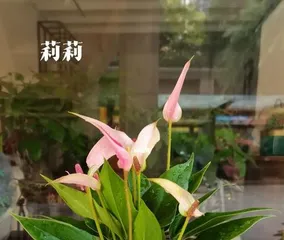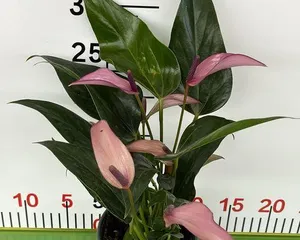In the fast-paced modern city life, many people like to create a warm and comfortable environment at home to relax. Placing some green plants at home can not only purify the air but also add vitality and beauty to the living space. The anthurium, as a green plant very suitable for indoor care, is widely loved by people. Is it good to keep anthurium at home? Is the anthurium suitable for indoor cultivation? This article will provide a detailed introduction for everyone.

I: Basic Knowledge of Anthurium
Anthurium is an evergreen ornamental foliage plant native to the tropical and subtropical regions of South America. Its leaves are long and narrow, with a dark green color. The flowers are small and exquisite, with colors ranging from peach to pink, very beautiful. Its biggest advantage is that it is suitable for indoor care.
II: Suitable Growing Environment for Anthurium
Anthurium thrives in a warm and humid environment, with the optimal temperature being 18-25°C, and it should not be lower than 10°C. It does not have high requirements for light, but it cannot be under strong light for a long time, otherwise the leaves are easily sunburned. It is best to place it in a shaded area.

III: Choosing the Right Potting Soil
Choosing the right potting soil is an important part of anthurium care. It is recommended to use well-draining soil containing leaf mold or peat, and add an appropriate amount of vermiculite or perlite for improvement.
IV: The Correct Watering Method
The principle for watering anthurium is "water frequently but not in large amounts," avoid overwatering to prevent problems like waterlogging and root rot. Each watering should thoroughly moisten the entire pot of soil, but avoid watering the leaves to prevent rot.
V: Proper Fertilization
Anthurium needs to be fertilized during its growing period, but not excessively, to avoid adverse effects on the roots. It is recommended to use soil containing leaf mold, peat, and perlite, and to apply fertilizer once a month in spring and autumn.

VI: Pay Attention to Ventilation
The indoor environment is relatively enclosed, so attention must be paid to ventilation during the care of anthurium to prevent excessively high leaf humidity, which can lead to diseases.
VII: Prune in a Timely Manner
During its growth period, anthurium will produce some old leaves that need to be pruned in a timely manner to avoid affecting its growth and development, and it also contributes to the overall aesthetics of the plant.
VIII: Preventing Pests
During its growth, anthurium may encounter some pest problems, such as aphids and whiteflies, and timely measures need to be taken, such as spraying with pesticides.
IX: Repositioning Appropriately
Anthurium is suitable for indoor care, but it should be repositioned appropriately to avoid the leaves growing in the same direction for a long time due to staying in the same position.
X: Pay Attention to Temperature Changes
Winter is the "dormant period" for anthurium growth. At this time, pay attention to temperature changes to avoid excessively low temperatures affecting its growth.
XI: Avoiding Strong Light
Anthurium should avoid long-term exposure to strong light, as it can easily cause the leaves to turn yellow and damage the growth point.
XII: Regular Cleaning
Dust can easily accumulate on the leaves of anthurium. Wiping the leaves regularly with a damp cloth can maintain their beauty.
XIII: Maintaining Humidity
Anthurium is suitable for growing in a humid environment. The potting soil should be kept moist, but care should be taken to avoid waterlogging.
XIV: Timely Disease Management
During its growth, anthurium may encounter some disease problems, such as bacterial and fungal diseases, which require timely treatment measures.
XV:
As a green plant very suitable for indoor care, anthurium has great ornamental value. During the care process, attention needs to be paid to watering, fertilizing, pruning, and pest control, and maintaining appropriate temperature and humidity can allow it to grow healthier and more beautiful.